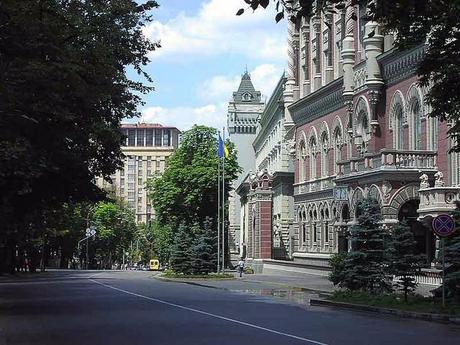Pechersk-Lipki
To the south-east of Kreschatik Street there is a height that in the old days used to be called Klov after the Klov creek that rounded it. Nowadays the former Klov height consists of two districts, which are Pechersk and Lipki. The main thoroughfare of the region, Gryshevskogo Street, begins at the Kievo-Pecherskaya Lavra, which gave the name to Pechersk, and leads to the Evropeyskaya, or European, Square.
Pechersk is an old district that contains many architectural sights, historical buildings and monuments, including Arsenal of Pecherskaya Fortress, the grandeur building of Soviet of People's Commissars, the Museum of Ukrainian Art shaped as a Greek temple.
Lipki is a historical area of Pechersk. In 1744 the lime-tree grove was planted on this place, so it was called Lipki, which means little lime-trees. Russian Empress Elizabeth chose the site for her summer residence and ordered court architect Bartholomeo Rastrelli to build a palace for her. Nowadays the citizens of Kiev and the guests of the city can admire the beauty of Mariynsky Palace, which is the miniature replica of French Versailles. Kiev noble families were attracted by perspective of having their mansions close to the Royal palace, so they started to put up their palaces close to the Mariynsky palace. Lipki became aristocratic region, where governors of Russian provinces and their families, as well as the richest persons of those times lived.
In Lipki there is Klovsky Palace that was put up in 1756 and intended for honorable guests of Kievo-Pecherskaya Lavra. Now the palace contains the exposition of Kiev History Museum. In 1833 the lime-tree grove was cut and the district became the administrative center of the city. The house of governor general and his chancellery, the mansion of Kiev Commander-in-Chief, bank departments were located in Lipki. Traditions that were founded at the beginning of the 18th century are carefully kept today, and Lipki still remains an administrative district of the Ukrainian capital: Ukrainian President Administration, Supreme Soviet, National Bank, Government House and other important government buildings are situated in this district.
Pechersk and Lipki are very nice places for walking. Here old restored mansions adjoin new houses, and green trees help escaping summer heat. There are several houses that have unusual names. For example, the mansion built at the beginning of the 20th century in Art Nouveau style is called the House of Crying Widow. It was named after the decoration element of facade representing the face of a beautiful woman. When it rains the water drops run down woman's face and create an impression of crying lady. Another unusual construction is called Chocolate House. The building used to belong to patron of art Mogilzhev. The weird name of the house could be explained by its brown color and facade decorations that look like chocolate segments. The building used to be Wedding Palace.
Recently the streets of Pechersk and Lipki were returned their original names, and nowadays one can enjoy walking along the old lanes and discover new nooks of Kiev history. Such streets as Institutskaya, Shelkovichnaya, Luteranskaya and Bankovskaya are especially charming.
Pechersk was named after Kiev Pechersk Lavra and Lipki – after the gorgeous lime tree alley, which was laid for Klovskiy Palace along present-day Lipskaya Street in the 17th century. But mansions of Kiev grand people, which were actively built at that time, eventually pressed the sweet “special appeal” of Pechersk. Up to the beginning of the 18th century Pechersk upland consisted of backwoods; there were no city constructions there. Only two holy cloisters – Pechersk and Deserted – Nikolayevskaya huddled in the backwoods. But at the times of Russian Empire the area was turned into a fortress: first, Petr1 surrounded Lavra with defensive ramparts and after him Emperor Nikolay finished construction of the fortress and broadened it over the whole present-day upland - Pechersk. He was the one, who set the aristocracy`s tradition to live there, when he founded Mariinskiy and Klovskiy Palaces.




